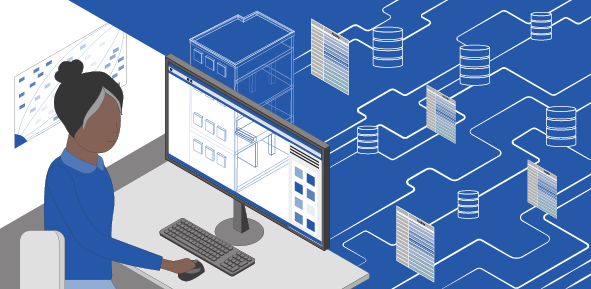
Our Challenge
Running behind the scenes of digital assets would be vital and huge infrastructure comparable to the power grid and sewers that connect and serve the built environment. This digital infrastructure would securely deliver data to the right place at the precise right time, and be designed to ensure the safety and performance of built assets such as bridges, trains and lifts by performing automatic checks and risk assessments. Digital infrastructure will bring together data from diverse sources to create new and valuable collective insights. However, to make this possible the digital infrastructure requires standardization and buy-in. CDBB envisioned an Information Management Framework that facilitated interoperability across data sources, fostered a culture of purposeful information management and ensured the security of critical assets.
Our Solution
Along with collaborators at the Construction Innovation Hub and at other UK institutions, CDBB was developing the evidence base for standards for information management, exploring the issues around interoperability, security and whole life management of a wide variety of physical and digital assets (e.g. buildings and the files that make up digital models of those buildings).
Projects within this theme
| Projects within this theme | Lead researcher |
|---|---|
|
Digital Construction on a Shoestring Breaking down barriers to the practical deployment of digital solutions within construction |
Professor Duncan McFarlane |
|
Integrated Management of Margins through Evaluation, Design, Analysis, Tracking and Negotiation Analysing the causes of the over-engineering of systems, with a focus on hospital buildings and offering recommendations for designing flexible building services with suitable margins. |
Prof Claudia Eckert |
|
Line of sight: an Asset Management Methodology to Support Organisational Objectives |
Jennifer Schooling |
|
Mitigating the negative effects of complexity in healthcare design using BIM-based tools for automated compliance checking. |
Patricia Tzortzopoulos |
|
Digital Compliance Network (D-COM) The entire lifecycle of the built environment is governed by regulations, requirements and standards. Compliance is a complex task, which can be eased by the adoption of BIM. This workshop brought together stakeholders from industry and academia. |
Dr Tom Beach |
|
Identifying the level of maturity in immersive technologies in the built environment, including barriers and research priorities needed to adopt AR and VR technologies. |
Dr Manuel Davila Delgado |
|
Taking a user-centric approach to interacting with information, from search and retrieval to browsing and exploration. It includes a list of capabilities needed to better understand the information management needs of a digital built Britain. |
Dr Peter Demain |
|
Understanding the state-of-the-art in use of modelling support to inform infrastructure planning decisions, both in industry and policy practice, and in the research community. Improvements in data availability and transparency are critical enablers, influencing the success or failure of projects. |
Dr Chris Dent |
|
Co-Evolving Built Environments and Mobile Autonomy for Future Transport and Mobility Tackling the challenges of autonomous navigation by considering the interaction of the autonomous vehicles with the environments in which they operate. |
Dr Amanda Prorok |
|
Using advanced image processing and computer vision techniques to recreate geospatial viewpoints of 17th-century line drawings of Cambridge colleges. Drone flights captured current images of the colleges and the project shows that we can overlay the image and the drawing, highlighting differences and similarities. |
Dr Michael Ramage |
|
Digital Energy Estimation Tool (DEET) Enabling the generation of real-time data from operational energy use and from energy embedded in building components so that buildings can be designed to be greener using BIM-based modelling. |
Dr Zaid Alwan |
|
Reducing the vulnerability of information to threats during its lifespan by developing a holistic IR model to demonstrate how information in digital built Britain could be made resilient throughout its lifecycle. |
Dr Karen Blay |
|
Toward Blockchain – enabled construction supply chains: Potential, requirements and implementation Understanding the real potential of Blockchain for construction supply chains and proposing a comprehensive implementation framework. |
Dr Algan Tezel |
|
From Norm to Swarm: development of a Balanced Score Card for evaluating automation in construction Developing a Balanced Score Card (BSC) to support the adoption of automation in construction. The BSC approach gives a more holistic way of measuring and evaluating success by taking into consideration social, environmental and other aspects in addition to KPIs. |
Dr Isolda Agusti Juan |
|
IOT Network Behaviours and Dependencies Exploring the types and rates of data off-the-shelf IOT sensors will generate and distribute, the supporting services they will invoke and the infrastructure dependencies they imply for digital built Britain. |
Dr Richard Mortier |

